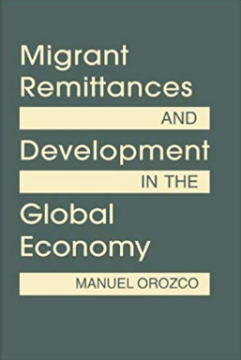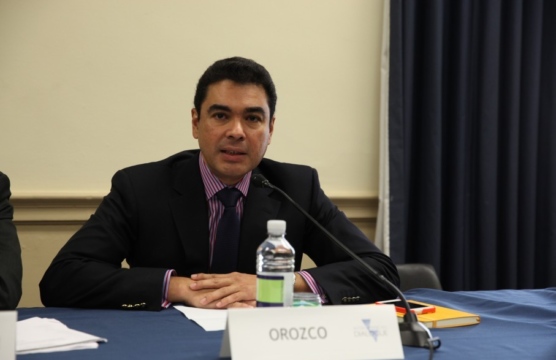The Earthquake’s Impact on Remittances
The earthquake in Haiti has exacerbated an existing distress during the international recession and increased uncertainty of what to do and how to help.
A Daily Publication of The Dialogue
Remittances using cryptocurrencies grew 900 percent worldwide last year, with Venezuela, Argentina, Brazil, Mexico and El Salvador showing high levels of growth in crypto money transfers, crypto exchange Coinpay.cr said in February. How significant is cryptocurrency’s share of remittances to Latin America and the Caribbean, and will high levels of growth continue in the coming years? What has fueled the growth of remittances using cryptocurrencies, and what do the trends suggest for Latin America’s traditional remittances channels? What are the potential upsides and risks of greater use of crypto in sending money transfers?
Manuel Orozco, member of the Financial Services Advisor board and director of the Migration, Remittances and Development Program at the Inter-American Dialogue: “Migrants are yet to become familiar with cryptocurrencies and earn the purchasing power to consider its use for transactions, rather than investment. The volume has not exceeded more than (a non-negligible amount of) $300 million out of $135 billion received in remittances last year (excluding the use of crypto as intermediary payment settlement then converted into U.S. dollars). El Salvador’s Chivo wallet, for example, captured $57 million in the fourth quarter of 2021 and $12 million in the first quarter of 2022, and not all transactions performed by the wallet were in crypto. The money transfer industry is still wary of engaging with this currency because of regulatory caveats that need to be addressed; on the end side, the financial and commercial ecosystem is not crypto friendly—not even in El Salvador. The Venezuelan experience reflects anecdotal evidence of digital nomads temporarily transacting with crypto. However, the reality is that in a country with six million migrants, and only 2.5 million able to send money, sending dollars is what is much needed to help families. Because nothing is static and the dynamism of new generations of migrants with higher purchasing power and economic interests is growing, it is important to prepare the global payment ecosystem to integrate crypto as another transactable payment. The natural process will likely exhibit higher responses perhaps than the use of digital dollar transfers (because of demand, not supply factors), which are at 25 percent of all remittance transactions today. But the timing is yet to be determined. As of 2021, 50 percent of migrants in the United States were still relying on cash to perform day-to-day bill payments, of which one quarter is remittance transfers. It is hard to speculate that migrants in the United States, and much less in Chile, Costa Rica and the Dominican Republic, can afford to obtain crypto to send money in the near future. Their income is four times lower than the average crypto user. It is important to separate publicity from facts.”
Julia Yansura, program manager for Latin America and the Caribbean at Global Financial Integrity: “Migrant communities are incredibly diverse, and this extends to how they use financial services. Some individuals prefer going in person to send money home, in cash. Some send remittances via computers or smartphones, paying with credit or debit cards linked to bank accounts. Finally, a small but growing group is sending via crypto transfers. That said, statements such as the one by Coinpay.cr risk overstating the trend. Crypto remittances, despite their growth, remain small; 900 percent growth of a fraction of a percentage is still only a fraction of a percentage. Even in El Salvador, where Bitcoin is legal tender, family remittances via cryptocurrency digital wallets represent just 1.62 percent of remittances received as of March 2022. This is a fascinating trend to watch, but it would be inaccurate to say that crypto remittances have taken over the market. In terms of consumer adoption, surveys have shown that migrants look for reliability, ease of use and speed when selecting a remittance service provider. In this regard, barriers to adoption for crypto remittances include volatility and complexity. The most interesting aspect of crypto and remittances is not direct consumer adoption of crypto, but rather the ways that the blockchain technology behind crypto could be used for cross-border payment settlements by remittance companies. This has powerful potential to simplify processes and lower costs, offering benefits to the industry as well as to migrant consumers”
James Bosworth, author of the Latin America Risk Report: “Remittances are a potential ‘killer app’ for cryptocurrency in emerging markets. There is high potential upside in giving citizens ways to transfer money both within countries and across borders without high fees and bureaucratic red tape. While electronic payments are booming across the hemisphere, too many payment systems and traditional banks operate ‘gated communities’ in which they do not interact easily or cheaply with each other. Cryptocurrencies are one potential solution to that problem (so are central bank digital currencies and government-backed systems like Brazil’s Pix; crypto isn’t the only alternative). In some countries, government currency controls and restrictions make cryptocurrencies an ideal workaround. Yet we shouldn’t oversell where cryptocurrencies are today. While growth in crypto remittances has been significant in a few countries, the numbers remain quite small as a percentage of all remittances. Remittances in the highest-profile example of cryptocurrency use in the hemisphere, El Salvador, operate on a government-controlled wallet that falls far short of an ideal decentralized and inter-operable system. For cryptocurrency to succeed, governments and private sector companies must act to implement serious regulations that combat scams, hacking attempts, criminal money laundering, tax evasion and systemic threats within the stablecoin world, all while not overly restricting innovation. That’s a hard task, and many governments will fail to get that balance correct in the short term. While crypto remittances are likely to continue to grow in the coming years, the ‘wild west’ regulatory environment in many countries is going to limit its potential and may give space for non-crypto alternatives in the fintech world to also gain a foothold”
Laura Porras, senior program manager at Plan International USA: “For people already using crypto, using it for remittances is a small step. For those with few options, it’s a worthy one. For Venezuela, cryptocurrencies may be one of the few channels available for sending, and the use of crypto is visible across the board for cross-border payments. In the case of El Salvador, the government itself has invested not only in a platform but has also provided economic incentives for people to sign up. For other countries, exceptional inflation is recognized as a likely factor. Most of this growth, maybe with the exception of El Salvador, comes from current crypto users, which is still a small group. For crypto to actually grow to a relevant market share, there needs to be a push from the demand side for a relevant amount of senders. Remittances using cryptocurrencies have not proven to be cheaper for consumers. There are costs associated with wallets and cashing in and out, as well as volatility in exchange rates. Chivo, El Salvador’s government-backed wallet, clearly informs their customers of the associated costs for using Bitcoin (this on its own is also an opportunity for other currencies). This is a sunk cost to those already using it but an entry cost for those who are not. Once crypto is more widely used, ideally pushed by technology and inclusion and not by stressed economies, crypto may grow at a relevant pace. Meanwhile, adoption will be limited. Legislation will also play an important role. Crypto is a great tool, but making it mainstream will take change from both legacy and new financial actors, as well as time and adaptation.”
Kai Schmitz, partner at Crestone Venture Capital: “Latin America includes some of the countries with the highest adoption of cryptocurrencies for purposes other than speculation, mostly as an inflation-proof store of value, a hard currency holding that is secure from government intervention or a means of transfer. In Venezuela and Argentina, people have looked to cryptocurrencies to achieve these objectives. Cryptocurrencies still have many shortcomings including complicated onramps and offramps, high fees, poor know-your-customer rules, a high risk of fraud and extreme volatility. Their success despite these problems is not only due to the investment returns some cryptocurrencies have generated, but it also demonstrates the demand for a truly digital currency that is easily transferable from person to person without intervention and costs associated with payment schemes and governments. This use case is driven by high merchant discounts and strangling restrictions of card schemes, the ridiculously poor infrastructure for international transfers and government overreach. Using crypto for remittances solves several of these problems, but it has its own challenges: a high cost of conversion out of and back into fiat, a risk of money laundering, the volatility of value and limited acceptance. However, as crypto becomes more accepted and the overall infrastructure improves, these problems will gradually go away and will significantly increase the use of crypto for remittances and purchases. Gaming and social media in the metaverse will drive consumer adoption of web3 faster than most people imagine, including in Latin America. Tokens and cryptocurrencies are the native currencies for this new economy and will create the payment use case that is currently missing. Stablecoins offer people in Latin America the ability to save in hard currencies, inflation is high or savings in U.S. dollars are at risk of government seizure. El Salvador, where Bitcoin has become legal tender, is a different case because rather than the population trying to evade economic policies of the government, the government is using cryptocurrency for its own benefits. Western countries utilizing their hard currencies for political objectives through sanctions and restrictions of access to important payment infrastructure drive this other use case, although not one the cryptocommunity should embrace."
 The Latin America Advisor features Q&A from leaders in politics, economics, and finance every business day. It is available to members of the Dialogue’s Corporate Program and others by subscription.
The Latin America Advisor features Q&A from leaders in politics, economics, and finance every business day. It is available to members of the Dialogue’s Corporate Program and others by subscription.
The earthquake in Haiti has exacerbated an existing distress during the international recession and increased uncertainty of what to do and how to help.
How do patterns of migration and remittances differ across regions? What kinds of frameworks support the contributions of remittances to local development?
On February 24th, the Inter-American Dialogue held its annual event on Remittances to Latin America and the Caribbean.
 Senders of remittances are increasingly using cryptocurrencies such as Bitcoin. However, money transfers using cryptocurrencies remain a small part of the market. // File Photo: André François McKenzie via Unsplash.
Senders of remittances are increasingly using cryptocurrencies such as Bitcoin. However, money transfers using cryptocurrencies remain a small part of the market. // File Photo: André François McKenzie via Unsplash.

